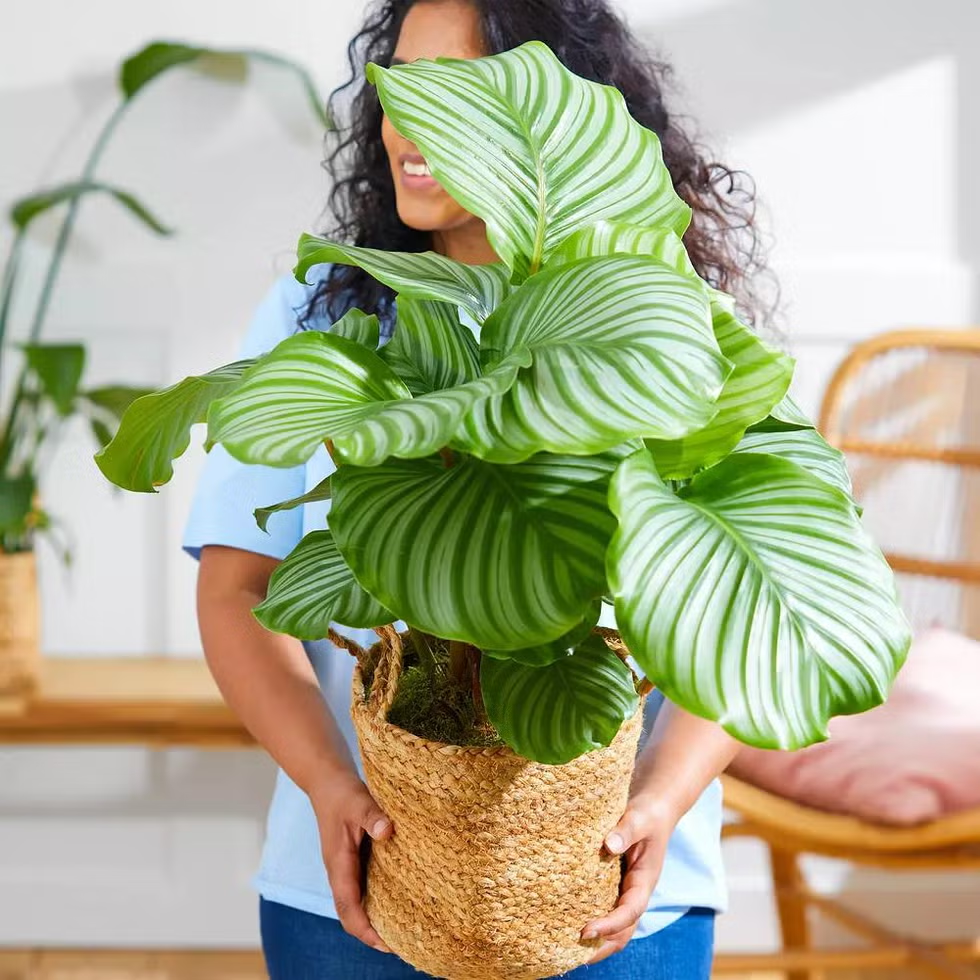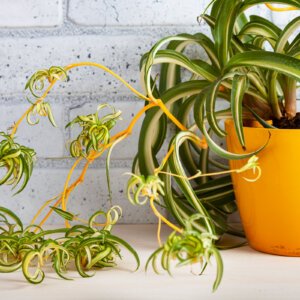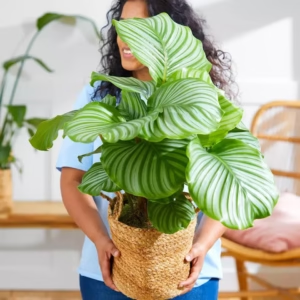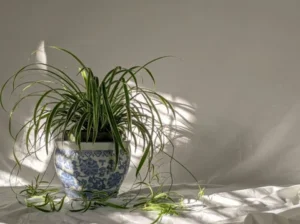The Calathea plant is one of the most stunning tropical houseplants, admired for its bold patterns, colorful leaves, and ability to thrive indoors. Also called the “Prayer Plant” because its leaves fold at night, Calathea adds beauty and freshness to any home. In this guide, we’ll explore Calathea care, its benefits, common problems, propagation, and why it’s a top choice for indoor gardening.
What Is a Calathea Plant?
The Calathea plant belongs to the Marantaceae family and is native to South America. Its wide leaves display artistic patterns in shades of green, silver, pink, and purple. Unlike other houseplants, it moves its leaves daily, folding them upwards at night as if in prayer.
Because of its attractive foliage, it is one of the best indoor plants for people who want to brighten up their living spaces.
Popular Varieties of Calathea
There are more than 300 Calathea varieties, and each one has a unique look. Some favorites among houseplant lovers include:
- Calathea Orbifolia – Large, rounded leaves with silver stripes
- Calathea Medallion – Bright green leaves with deep purple undersides
- Calathea Zebrina – Zebra-like striped foliage
- Calathea Lancifolia (Rattlesnake Plant) – Long leaves with spotted designs
- Calathea Makoyana (Peacock Plant) – Beautiful leaves resembling peacock feathers
Benefits of Calathea Plant
Growing a Calathea plant indoor provides more than just beauty. It also improves air quality and creates a calming atmosphere. Similar to other indoor plants that clean the air, Calathea absorbs toxins and increases oxygen levels in your living space.
Key Benefits:
- Acts as a natural air purifier
- Enhances home décor with its patterned foliage
- Safe for pets and children (non-toxic)
- Reduces stress and boosts mood
- Adds tropical vibes to bedrooms, living rooms, and offices
Light and Temperature Needs of Calathea
Understanding Calathea light requirements is crucial for healthy growth.
- Light: Calathea thrives in bright, indirect light. Direct sunlight can fade or burn its leaves.
- Temperature: The ideal range is 65–80°F (18–27°C). Keep it away from drafts, heaters, or air conditioners.
Watering and Humidity for Calathea
The Calathea plant enjoys consistently moist soil but hates soggy roots. Always water when the top inch of soil feels dry. Since it is sensitive to chemicals, use distilled or rainwater instead of tap water.
Humidity Tip: Calathea loves humidity above 50%. If your home is dry, consider keeping it inside an indoor greenhouse or placing a humidifier nearby.
Best Soil and Fertilizer for Calathea
- Soil Mix: A combination of peat moss, perlite, and organic potting soil works best.
- Fertilizer: Apply a diluted liquid fertilizer once a month during the growing season (spring and summer).
Calathea Plant Care Table
| Care Factor | Requirement |
|---|---|
| Light | Bright, indirect light |
| Watering | Keep soil slightly moist |
| Temperature | 65–80°F (18–27°C) |
| Humidity | Above 50% |
| Fertilizer | Monthly during spring & summer |
How to Propagate Calathea
Unlike some plants that can be grown from cuttings, Calathea propagation is best done through division.
Steps:
- Gently remove the plant from its pot.
- Separate a healthy section of roots and stems.
- Plant the divided section in fresh potting soil.
- Keep it in a warm, humid place until it establishes.
Common Problems with Calathea Plant
Even though it’s a hardy plant, Calathea can face some issues:
- Yellow leaves – Overwatering problem
- Brown leaf edges – Low humidity or hard tap water
- Curling leaves – Underwatering or too much light
- Pests – Occasionally affected by spider mites or aphids
For plant lovers who want easy-care plants, check out the top 50 indoor plants that thrive with minimal effort.
Best Placement for Calathea Indoors
The ideal spots for a Calathea plant include:
- Living rooms with filtered light
- Bedrooms for a relaxing atmosphere
- Bathrooms with natural humidity
- Offices for an elegant touch
Calathea vs Other Indoor Plants
Compared to plants like the Purple Heart or Spider Plant, Calathea is a bit more sensitive. While it requires higher humidity and clean water, its striking patterned leaves make it one of the best indoor plants for decoration and wellness.
FAQs About Calathea Plant
1. Why are my Calathea leaves turning brown?
This usually happens due to low humidity or using tap water with fluoride and chlorine. Switch to distilled water and increase humidity.
2. Is Calathea safe for pets?
Yes, Calathea is non-toxic to cats and dogs, making it a safe choice for homes with pets.
3. How often should I water my Calathea plant?
Water once the top inch of soil feels dry. Keep the soil moist but never soggy.
4. Can Calathea survive in low light?
Yes, Calathea tolerates low light but thrives best in medium to bright indirect light.
5. How big does a Calathea plant grow?
Most Calathea varieties grow up to 2 feet tall indoors, depending on the type and care.
6. Can Calathea be grown outdoors?
Yes, but only in warm tropical regions. In cooler climates, it should be kept indoors.
Final Thoughts
The Calathea plant is a tropical beauty that brings elegance, health, and vibrancy into your home. While it requires slightly more attention than some other indoor plants, its striking foliage, air-purifying benefits, and non-toxic nature make it one of the best indoor plants for any plant lover.





